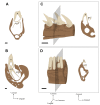Current Perspectives on Tooth Implantation, Attachment, and Replacement in Amniota
- PMID: 30519190
- PMCID: PMC6258785
- DOI: 10.3389/fphys.2018.01630
Current Perspectives on Tooth Implantation, Attachment, and Replacement in Amniota
Abstract
Teeth and dentitions contain many morphological characters which give them a particularly important weight in comparative anatomy, systematics, physiology and ecology. As teeth are organs that contain the hardest mineralized tissues vertebrates can produce, their fossil remains are abundant and the study of their anatomy in fossil specimens is of major importance in evolutionary biology. Comparative anatomy has long favored studies of dental characters rather than features associated with tooth attachment and implantation. Here we review a large part of the historical and modern work on the attachment, implantation and replacement of teeth in Amniota. We propose synthetic definitions or redefinitions of most commonly used terms, some of which have led to confusion and conflation of terminology. In particular, there has long been much conflation between dental implantation that strictly concerns the geometrical aspects of the tooth-bone interface, and the nature of the dental attachment, which mostly concerns the histological features occurring at this interface. A second aim of this work was to evaluate the diversity of tooth attachment, implantation and replacement in extant and extinct amniotes in order to derive hypothetical evolutionary trends in these different dental traits over time. Continuous dental replacement prevails within amniotes, replacement being drastically modified only in Mammalia and when dental implantation is acrodont. By comparison, dental implantation frequently and rapidly changes at various taxonomic scales and is often homoplastic. This contrasts with the conservatism in the identity of the tooth attachment tissues (cementum, periodontal ligament, and alveolar bone), which were already present in the earliest known amniotes. Because the study of dental attachment requires invasive histological investigations, this trait is least documented and therefore its evolutionary history is currently poorly understood. Finally, it is essential to go on collecting data from all groups of amniotes in order to better understand and consequently better define dental characters.
Keywords: acrodonty; amniota; evolution; periodontium; pleurodonty; thecodonty; tooth implantation; tooth replacement.
Figures








References
-
- Auffenberg W. (1988). Gray’s Monitor Lizard. Gainsville FL: University Press of Florida.
-
- Bell G. L. (1997). “Chapter 11 - a phylogenetic revision of north american and adriatic mosasauroidea,” in Ancient Marine Reptiles, eds Callaway J. M., Nicholls E. L. (San Diego: Academic Press; ), 293–332.
-
- Bellairs A., Miles A. (1960). Apparent failure of tooth replacement in monitor lizards. Br. J. Herpet. 2 189–194.
Publication types
LinkOut - more resources
Full Text Sources
Research Materials

